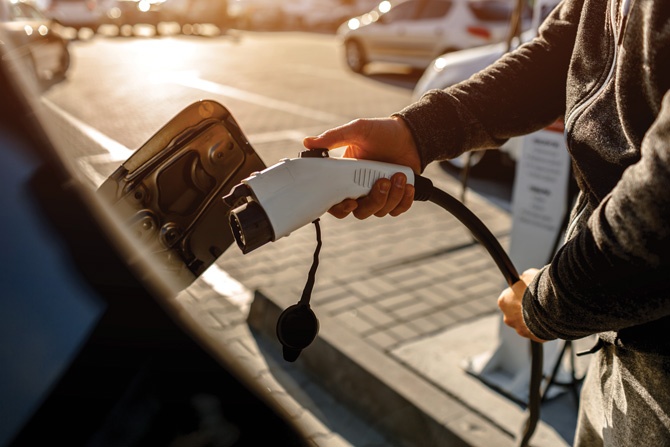The global move toward vehicle electrification has been going on for a long time now, but it is understandable if you feel like it will never arrive since few manufacturers have sent many EVs to dealer showrooms. Two of the controlling factors are regulations and the cost of building the necessary infrastructure.
Although change is coming, it is still slow. NADA’s market beat for June 2021 and July 2021 ends with a graphic for powertrain market share. The percentages should surprise no one:
- Gasoline has 87.5% of the market. The percentage at the end of June 2021 was 88.4%.
- Diesel market share was 4.0% (up from 3.6% in June).
- Hybrid market share was 5.0% (versus 5.0% in June).
- Electric market share was 2.4% (the same as in June).
- Plug-in hybrid market share was 1.1% (versus 0.8% in June).
What are the important trends? One source of expertise is the McKinsey Center for Future Mobility, which offers advisory services to its clients. It has four hubs: Beijing, Detroit, Munich and Silicon Valley, and it advises many OEMs and other key stakeholders. The website for the McKinsey Center for Future Mobility lists four major trends in the automotive industry that will transform it and also have a ripple effect on other industries such as insurance:
- Autonomous driving: Driver-assist technologies are making it safer for people to drive. Eventually, people will be passengers instead of drivers, and by 2030, the robotaxi market will control 70% of the market.
- Connectivity: Engineers will continue connecting cars to information systems. Asutoth Padhi, a senior partner at McKinsey & Company, has said, “A car is really a supercomputer on wheels.” So far, people generally seem to like driving these supercomputers. Of potential buyers who answered a survey, 40% would switch automobile brands to gain more connectivity than they currently have.
- Electrification: The industry is nearing an inflection point caused by changing regulations, infrastructure, battery economics and market demand. The website says that in 2016, 30-40% of the people in the U.S. and U.K. considered buying an EV. Drew Desilver wrote an online article on the Pew Research Center website, dated June 21, 2021, with more recent numbers. In the article, Drew Desilver said 7% of U.S. adults own an electric or hybrid vehicle, and 39% of survey respondents said they would consider buying an EV the next time they look for a new vehicle.
- Shared mobility: Car ownership is convenient but expensive. New alternatives hope to offer equal or almost equal convenience without the stress and expense. However, shared mobility is still in the dream category since less than 1% of all miles traveled globally resulted from e-hailing trips.
During a company video, Asutoth Padhi said the U.S. has had two inflection points: the shift from horses to cars and the current shift to electrification. However, since electrification probably won’t be profitable for another 3-5 years, industry participants reasonably want to know who will fund the necessary losses between now and then. It isn’t clear what the answer is to that question, but answers may come through collaboration and changes in regulations and technology.
The McKinsey Center for Future Mobility wrote a 79-page publication about the upcoming changes. The report doesn’t include a publication date, but it does have information from the Aug. 31, 2019, IHS Markit Alternative Propulsion Forecast. Scan the QR code at the end of this article for the full report. The remainder of this article contains highlights from the report.
Gasoline and diesel engines have dominated the industry for more than 100 years, but government mandates have pushed the industry toward more efficient and environmentally friendly transportation. McKinsey’s experts worked to provide information about the following questions:
- What power train changes are being made? The report focuses on why, to what extent, where, and when.
- What are the most important changes relative to systems and main components?
- How will changes affect current powertrain value chains?
- How can suppliers respond successfully?
The report divides the component market into powertrain type, region and vehicle segment between 2018 and 2025. The report identifies strengths and weaknesses and assesses development and adoption trajectories for new powertrain technologies. It then offers a component by component analysis in four ICE component categories, three high-voltage categories, electrification categories and one fuel cell category.
The report offers the following conclusions:
- Buyer preferences and stronger CO2 regulations have created a tipping point for electrification. Battery costs are going down, and the U.S. is likely to increase the pace of building the necessary infrastructure for more charging stations. As a result, major markets will start distributing more EVs between now and 2025.
- The rate of adoption between now and 2030 is going to be regional. Adoption will be determined by buyer preferences, infrastructure, regulation, technology and total cost of ownership. These forces, and the vehicle choices people have, are not the same throughout the country, and adoption will be affected accordingly.
- Powertrains are changing dramatically. While the need for some ICE components will stagnate or decline, the need for electrification components will cause pockets of growth. You need to understand the changes to know how to adapt to the market.
The report offers a four-part general strategy that anyone in the auto industry can use:
- Nobody knows exactly how the transition is going to take place. However, you can still analyze the situation for your specific region and identify trigger points that will change what happens in the market. Once you know what is happening or likely to happen in your region, communicate what you see within your community and organization. Continue to track trigger points such as evolving customer preferences, incentives and regulations so you can promptly make changes when the time comes.
- Keep an eye on global changes while managing performance focus areas that are specific to your business. You should know where you are doing well and where you have room to grow. Also, learn whether there are promising new markets to investigate.
- Allocate resources so that R&D efforts are going toward new markets while supporting backbone and legacy markets only as much as necessary. The idea is to invest as little as possible in technologies that are going away. That way, you will have as little loss as possible. Cooperate with OEMs, suppliers, and people in the public sector if there is an effort to bundle research efforts or mitigate infrastructure costs. It’s a little like having roommates in an apartment or multiple generations in a home: look for opportunities to reduce costs by sharing them.
- Being proactive about the need for change is better than just letting things happen and reacting to them after they become important. Before your organization makes big changes, you need to understand your organization’s transition-related strengths and weaknesses. Take advantage of strengths and minimize weaknesses to create a strategy that will help you steer your organization through the changes. As you go, you can adjust more quickly by paying attention to performance and accountability.
This advice is all general; it’s necessarily vague because it applies to so many possible situations. But you can make it more specific. Consider your service department, for example. It’s hard to know whether you should expand unless you have some idea of how soon it will be before maintenance for ICE vehicles decreases much more than it currently has. But you know that day is likely to arrive faster in, say, Washington D.C. and California than it is in Wyoming. Plan accordingly.
We are in the most exciting time for selling vehicles since Henry Ford started putting cars on the roads of North America. The new technology changes will improve the quality of life for everyone, especially as the technology begins impacting important areas such as carbon emissions and road safety. It’s going to be a glorious ride along the way.
To read the full report, go to: https://mck.co/39IMhbh










